Seasonal transitions hit restaurants, retail stores, facilities, and convenience stores harder than most realize. A failed HVAC system during summer lunch rush. Frozen pipes shutting down a c-store. Roof leaks damaging inventory in a retail location.
These aren't just maintenance issues; they're revenue killers.
The operations teams managing multi-unit portfolios know the drill as winter prep checklists in October, spring maintenance rounds in April, pre-summer HVAC inspections, and fall roof assessments.
But here's the problem: paper checklists, inconsistent execution, and zero accountability turn preventive maintenance into reactive firefighting.
.svg)

Priced on per user or per location basis
Available on iOS, Android and Web
The Problem with Traditional Seasonal Inspections
1. Paper Doesn't Scale Across Multi-Unit Operations
- Restaurants: Managing seasonal inspections across 50 restaurant locations with paper is chaos. Each GM interprets the winterization checklist differently. Some locations complete inspections thoroughly, others skip them entirely. Corporations have no visibility until something breaks.
- C-Stores: The c-store operator with 30 locations faces the same nightmare. Did the overnight manager complete the HVAC inspection at Store 12? Where's the documentation? What did they actually check? The paper either gets lost or filed away, where it's useless.
- Retail Industry: Retail chains need consistent spring maintenance across flagship stores and strip mall locations alike. But paper checklists create inconsistency. The exterior inspection at one location covers 15 items, while another barely checks the parking lot.

2. Zero Accountability for Follow-Through
A facility manager finds a roof issue during seasonal inspection. They write it down. Now what? With paper systems, that finding enters a black hole. Who's responsible for fixing it? When should it be done? Did anyone even see the note?
Restaurant equipment checks reveal a walk-in cooler struggling to maintain temperature. The finding goes on a clipboard. Three weeks later, during the dinner rush, the cooler dies. The inspection predicted it, but no one acted.
This accountability gap kills the entire purpose of seasonal inspections. Teams go through the motions without driving actual preventive maintenance.
3. Lost Historical Data
Last year's gutter cleaning report for your retail location? Somewhere in a filing cabinet. The pattern of HVAC issues across your restaurant portfolio? Impossible to track. Recurring safety assessment findings at specific c-store locations? Lost to time.
Without historical context, every seasonal inspection starts from zero. Teams can't identify patterns, predict failures, or prioritize locations needing extra attention. Data that should inform smarter maintenance decisions simply doesn't exist in any usable form.
4. Compliance Blind Spots
Health inspectors, insurance auditors, and corporate compliance teams all want proof of completed seasonal inspections. Paper documentation fails this test. Forms are incomplete, signatures are missing, dates don't match reality, and half the records can't be found when needed.
For restaurants, this creates health code risks. For retail and c-stores, it means failed audits and insurance headaches. For facilities teams, it's explaining to executives why you can't prove inspections happened.
Xenia - Most Modern Operation Execution Software
Xenia solves seasonal inspection chaos by bringing structure, intelligence, and accountability to multi-unit operations. Built specifically for restaurant, retail, facilities, and c-store operators, the platform turns seasonal inspections from administrative headaches into strategic assets.
1. Standardized Checklists Across All Locations: Create a checklist once and roll it out across every site instantly.
Every manager follows the same protocol, documents the same items, and maintains identical standards. Site-specific customization ensures flexibility without sacrificing consistency.
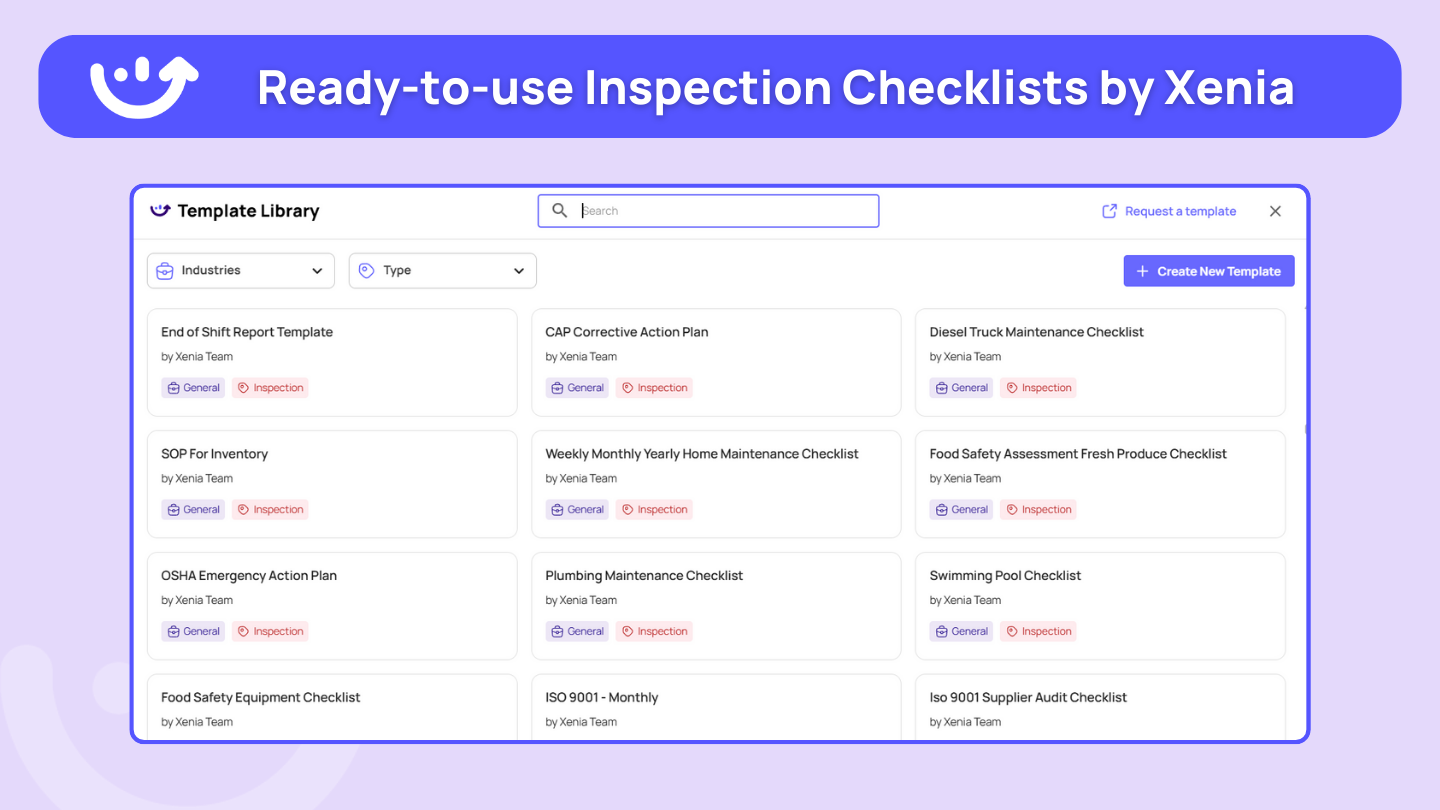
2. AI-Powered Insights That Prevent Failures: Xenia detects patterns across your entire inspection history, flagging recurring issues early and predicting failures before they happen.
The system auto-prioritizes high-risk inspections and recommends preventive actions based on real-world trends.
3. AI Summaries: Xenia automatically condenses inspections, incidents, and work orders into clear, executive-ready summaries. The AI highlights root causes, recurring issues, and next-step recommendations, saving time and improving operational clarity.
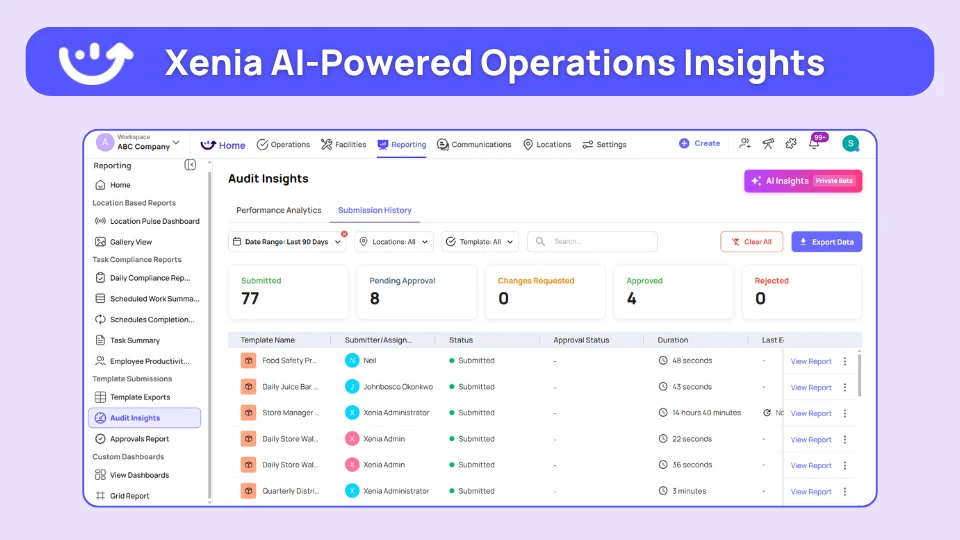
4. Automated Workflows That Force Accountability: Critical inspection findings automatically become tasks or work orders assigned to the right teams with deadlines and escalation paths.
Nothing gets ignored, and leadership sees real-time status across regions, buildings, or departments.
5. Mobile-First for Field Reality: Xenia’s offline-ready mobile app lets teams complete inspections anywhere, such as rooftops, basements, walk-ins, or parking lots. Required photos, fast checklists, and voice-to-text streamline fieldwork and drive high adoption.
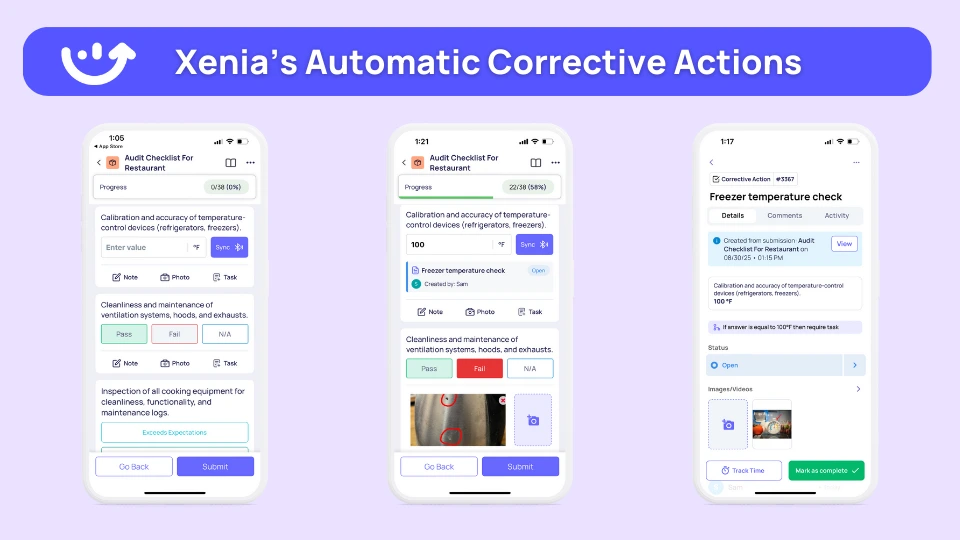
6. Centralized Logs With Complete History: Every inspection, photo, comment, and fix is stored in a single source of truth. Teams instantly see past issues and repairs, enabling smarter decisions and long-term pattern recognition. Knowledge stays with the system even when people leave.
7. Work Order Management: Turn issues into work orders instantly and assign them to internal techs or external vendors. Track progress, collect photo-based verification, and ensure completion with automated reminders and closeout documentation.
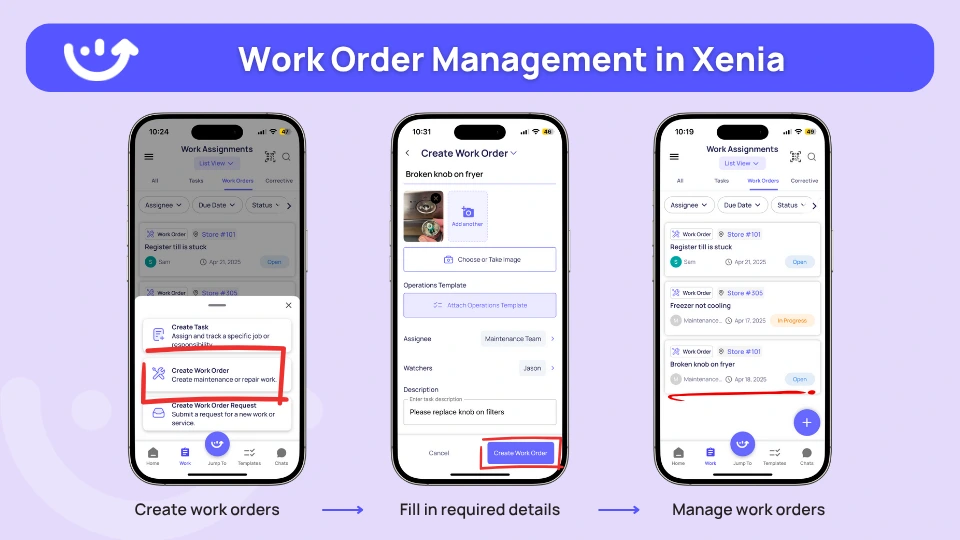
8. Live Reporting & Dashboards: Interactive dashboards show completion rates, open issues, asset health, and seasonal inspection performance in real time. Drill into specific locations, teams, or equipment to identify bottlenecks and track operational KPIs.
9. Temperature Monitoring: Continuously monitor walk-ins, coolers, freezers, and HVAC output with real-time temperature sensors integrated directly into Xenia. Automated alerts notify teams when temperatures drift out of range, preventing food loss, spoilage, and equipment failure.

10. AI Photo Rollout: Xenia’s AI scans uploaded inspection photos to confirm items were checked correctly, safety requirements were met, and equipment conditions match standards.
The system flags inconsistencies, auto-tags issues, and provides visual proof across all locations to ensure true compliance.
Essential Features for Multi-Unit Operational Excellence
A unified set of tools built to streamline inspections, maintenance, and compliance across restaurants, retail stores, facility portfolios, and c-store operations. Designed to standardize workflows while adapting to each industry's unique on-site challenges.
Season-Specific Templates: Build comprehensive winterization, spring maintenance, HVAC, roof, and equipment checklists tailored to each season’s risks. Templates stay consistent across locations while accommodating site-specific needs.
Winterization & Spring Protocols: Standardize heating checks, pipe protection, exterior assessments, gutter cleaning, landscaping readiness, and cooling prep, ensuring every location is properly prepared for seasonal shifts.
HVAC & Roof Inspection Checklists: Use pre-season HVAC templates for filter, refrigerant, and performance checks, and roof templates requiring photo documentation of drainage, materials, and high-risk areas.
Equipment Check Templates: Deploy preventive maintenance checklists for restaurant kitchen equipment, retail refrigeration, and c-store coolers and fuel systems, aligned with manufacturer recommendations.
Photo Requirements Built In: Ensure proof of work with required, timestamped, geo-tagged photos embedded directly into checklists. Before-and-after images validate maintenance, support audits, and track deterioration year over year.
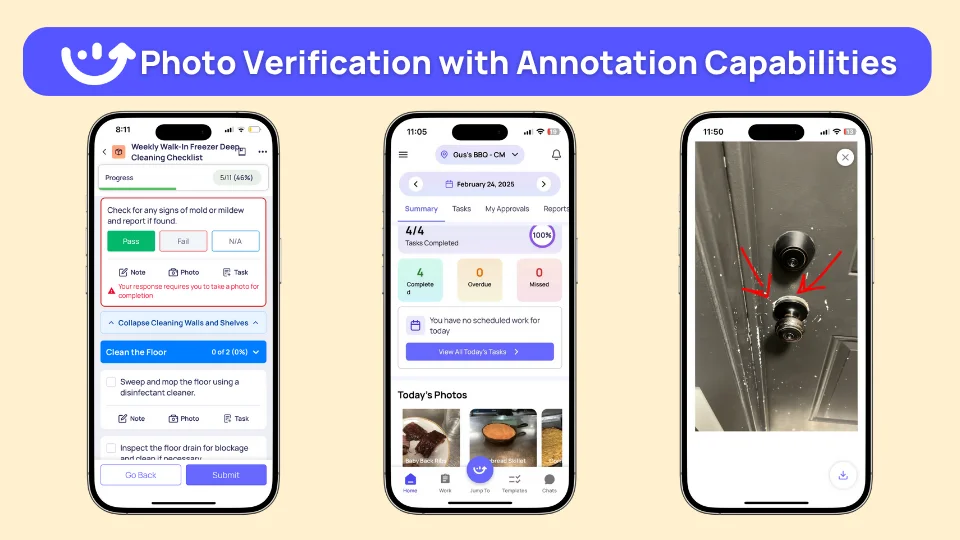
Real-Time Issue Escalation: Critical findings trigger instant alerts to district and operations leaders, ensuring hazards, failures, or urgent repair needs are addressed before they escalate into costly problems.
Compliance and Audit Readiness: Maintain complete digital records of all seasonal inspections, findings, and resolutions. Audit trails show who performed each task, when it occurred, and how issues were closed, supporting regulatory compliance and liability protection.
Implementation Strategy
1. Start With High-Impact Inspections: Begin with the seasonal inspections that create the most operational issues. Build solid templates with field manager input, pilot them at select locations, refine based on feedback, and then scale across the portfolio.
2. Involve Field Teams Early: Engage frontline managers in shaping templates to ensure they’re practical in real-world conditions. Provide clear, hands-on training that shows how Xenia reduces admin work, improves consistency, and supports their daily tasks.
3. Integrate With Existing Systems: Connect Xenia to your maintenance, communication, and BI tools so findings automatically generate work orders, alerts go to the right teams, and inspection data fuels strategic decision-making—without duplicate entry.
4. Monitor Performance Continuously: Track completion rates, issue resolution times, and recurring problem areas across locations. Use this visibility to identify gaps, strengthen accountability, and support sites that need additional attention.
5. Optimize Using Analytics: Leverage Xenia’s insights to uncover operational patterns, locations with repeated issues, inspections that surface the most findings, and equipment strained by seasonal demands. Use these insights to enhance your preventive maintenance strategy.
How to Obtain ROI with Seasonal Inspections
Consistent seasonal inspections lead to fewer equipment failures, longer asset lifespans, and significantly reduced emergency repair needs through proactive maintenance.
In industries like retail, restaurant, and c-store operators also strengthen their insurance profiles by documenting comprehensive safety and maintenance practices.
These unified inspection programs give organizations clearer visibility into asset conditions, improve capital planning decisions, and highlight underperforming or high-maintenance locations.
With standardized processes and complete documentation, corporate teams can confidently demonstrate operational excellence to franchisees, investors, and stakeholders.
Getting Started with Xenia

Xenia offers personalized demonstrations focused on your specific operations. Whether you manage restaurants, retail stores, facilities, or c-stores. See how the platform handles your actual seasonal inspection scenarios with templates relevant to your industry.
Free trials let you test Xenia with real inspections before committing. Import your current seasonal checklists, assign them to a few locations, and experience how the platform performs in your environment.
Implementation typically takes weeks, not months. Xenia's team supports template creation, user training, and integration setup to ensure successful launches. Pricing scales with your portfolio size, and ROI typically appears within the first year through reduced failures and extended asset life.
Conclusion
Seasonal inspections separate well-run multi-unit operations from those constantly fighting fires. The difference isn't the effort, it's the system. Paper checklists and inconsistent execution create gaps where failures breed. Digital standardization through platforms like Xenia closes those gaps.
Restaurant chains can't afford HVAC failures during peak season. Retail operations can't tolerate roof leaks that damage merchandise. C-stores can't accept frozen pipes shutting down locations. Facilities teams can't explain why preventive maintenance failures caused expensive emergencies.
Xenia transforms seasonal inspections from administrative tasks into strategic advantages. Standardized checklists, AI-powered insights, automated accountability, and centralized intelligence enable operations teams to actually prevent problems instead of just documenting them.
The question isn't whether your organization needs better seasonal inspection processes. You do. The question is when you'll implement the digital systems that make excellence possible. Your locations, your teams, and your bottom line will thank you.

.svg)
.webp)
%201%20(1).webp)






.svg)
%201%20(2).webp)








